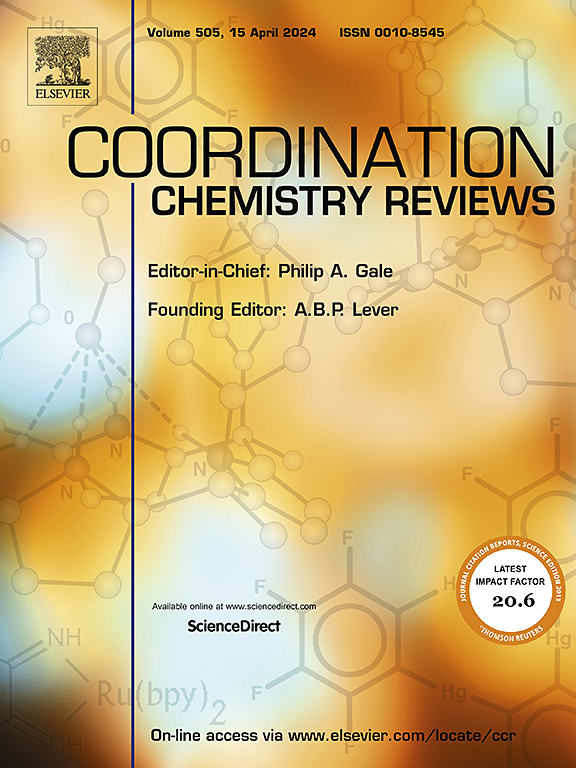Ion exchange membranes for valorizing CO2 Electroreduction: A deep dive into their pivotal role, challenges, and innovations
IF 20.3
1区 化学
Q1 CHEMISTRY, INORGANIC & NUCLEAR
引用次数: 0
Abstract
The escalating atmospheric levels of carbon dioxide (CO2) demand urgent breakthroughs in electrochemical CO2 reduction (e-CO2R) to convert CO2 to value-added chemicals and fuels. Ion exchange membranes (IEMs) are crucial to optimizing e-CO2R operations through ion conduction, charge balance, and reaction selectivity. This review provides an extensive comparison of the role, challenges, and recent advances in IEMs in the case of anion exchange membranes (AEMs), cation exchange membranes (CEMs), and bipolar membranes (BPMs) with a comparative analysis of the variations within each membrane. For AEMs, the comparison involves polymers like polysulfones, poly (arylene ether), and functional groups like quaternary ammonium to imidazolium to assess their contribution to hydroxide conductivity and alkaline stability. The comparison of fluorinated (e.g., Nafion) to non-fluorinated (e.g., sulfonated polyether ether ketone) materials follows the case of CEMs to determine proton conduction efficiency and cost. BPMs are considered through the aspect of layer composition (e.g., sulfonic acid to carboxylate interfaces) and how it affects water dissociation kinetics. The important performance characteristics like ion conductance, permselectivity, chemical stability, and mechanical durability are carefully considered within the various classes of materials. Methods like polymer backbone engineering, chemical crosslinking, nanostructured composites, and low-cost fabrication are reviewed within the frame of optimizations specific to the materials. The identification of research gaps like the lack of standardizing the comparison of the variations within the materials lays the emphasis on the need to create high-performance low-cost IEMs specific to the case of e-CO2R to move the pursuit towards a zero‑carbon economy.


离子交换膜用于二氧化碳电还原:深入探讨其关键作用,挑战和创新
大气中二氧化碳(CO2)含量的不断上升,迫切需要在电化学CO2还原(e-CO2R)方面取得突破,将CO2转化为增值化学品和燃料。离子交换膜(IEMs)通过离子传导、电荷平衡和反应选择性对优化e-CO2R操作至关重要。本文对阴离子交换膜(AEMs)、阳离子交换膜(CEMs)和双极膜(bpm)中IEMs的作用、挑战和最新进展进行了广泛的比较,并对每种膜内的变化进行了比较分析。对于AEMs,比较涉及聚砜、聚(芳烯醚)等聚合物和季铵到咪唑等官能团,以评估它们对氢氧化物电导率和碱性稳定性的贡献。比较氟化(例如,Nafion)和非氟化(例如,磺化聚醚醚酮)材料是在CEMs的情况下确定质子传导效率和成本的。bpm通过层组成(例如,磺酸到羧酸盐界面)以及它如何影响水解离动力学来考虑。重要的性能特征,如离子电导率、透性、化学稳定性和机械耐用性,在各种类型的材料中都被仔细考虑。聚合物骨架工程、化学交联、纳米结构复合材料和低成本制造等方法在材料优化的框架内进行了综述。对研究差距的识别,如缺乏对材料内部变化的标准化比较,强调了针对e-CO2R的情况创建高性能低成本集成制造设备的必要性,以推动对零碳经济的追求。
本文章由计算机程序翻译,如有差异,请以英文原文为准。
求助全文
约1分钟内获得全文
求助全文
来源期刊

Coordination Chemistry Reviews
化学-无机化学与核化学
CiteScore
34.30
自引率
5.30%
发文量
457
审稿时长
54 days
期刊介绍:
Coordination Chemistry Reviews offers rapid publication of review articles on current and significant topics in coordination chemistry, encompassing organometallic, supramolecular, theoretical, and bioinorganic chemistry. It also covers catalysis, materials chemistry, and metal-organic frameworks from a coordination chemistry perspective. Reviews summarize recent developments or discuss specific techniques, welcoming contributions from both established and emerging researchers.
The journal releases special issues on timely subjects, including those featuring contributions from specific regions or conferences. Occasional full-length book articles are also featured. Additionally, special volumes cover annual reviews of main group chemistry, transition metal group chemistry, and organometallic chemistry. These comprehensive reviews are vital resources for those engaged in coordination chemistry, further establishing Coordination Chemistry Reviews as a hub for insightful surveys in inorganic and physical inorganic chemistry.
 求助内容:
求助内容: 应助结果提醒方式:
应助结果提醒方式:


